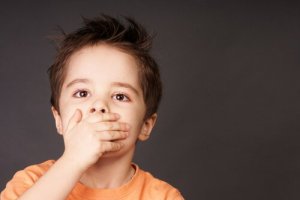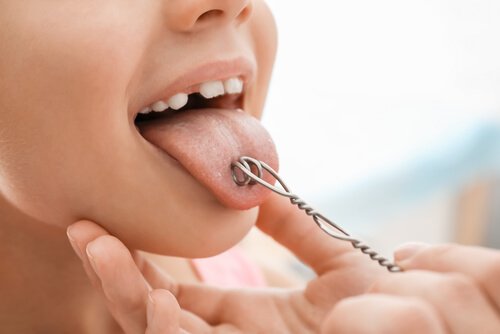Dysarthria in Children: Symptoms, Causes and Treatment

Have you ever heard of Dysarthria in children? How does it affect them? Below we’ll explain everything you need to know on the topic and what you can do to help your child.
Dysarthria isn’t a true language disorder, unlike disorders like Aphasia. Rather, it’s caused by poor function of the motor and sensory processes involved in producing speech.
In other words, Dysarthria is a disorder in which a child has a normal cognitive level and is able to understand the language of others, but is unable to correctly articulate words.
Dysarthria is a disorder that keeps the muscles involved in speech from moving correctly.
The Difference Between Language Disorders and Speech Disorders
Language disorders and speech disorders are often refered to interchangeably, yet this isn’t correct.
A language disorder indicates misidentification and mismanagement of stimulus signals from the environment. It can affect children’s cognitive development (mildly or seriously) although it isn’t always associated with an intellectual disability.
The main characteristics of language disorders are an inability to understand, learn, and articulate words.
The above doesn’t only occur at the level of vocal production and understanding, but also can involve the ability to read and write.

In general, language disorders appear without any muscular or respiratory dysfunction in the areas of the body that produce sound.
On the other hand, speech disorders are motor-based. In other words, they involve incorrect management of the neuro-muscular signals that articulate words. This doesn’t imply cognitive under-development in information processing.
To sum up, a speech disorder only affects control of the muscles used to produce words. Therefore intellectual capacity, senses, and functions of the nervous system aren’t affected by the presence of the disorder.
It’s important to distinguish between the two concepts because the treatment is different for Dysarthria versus other disorders such as Aphasia, Dysphasia, or reading and writing issues.
Most Common Characteristics of Dysarthria in Children
- Excessive saliva
- Difficulty swallowing.
- Limited control of vocal muscles.
- Noticeable restriction of jaw, tongue, and lip movement.
Children with Dysarthria may tend to isolate themselves. It’s also common for children who are affected to avoid speaking to others. This is because talking may be frustrating or embarrassing, and others may make fun of them.
If these children don’t get speech therapy and appropriate family support, they can develop social anxiety and other psychological disorders over time.
It’s important to show them you care and help them overcome their challenges over time. By taking care of their self-esteem, we can help them grow up to be adults who are emotionally healthy.
Possible Dysarthria Symptoms
- Talking in a whisper or very quietly
- Talking too slow or too fast.
- Talking with atypical articulation. It may sound forced or artificial.
- Abnormal intonation, sounding very sharp or hoarse.
- Inconsistent rhythm in articulating words, indicated interrupted speech.
For a definitive diagnosis of this condition, it’s best to see a pediatrician who specializes in neurology or child behavior.

Causes of Dysarthria in Children
Causes of Dysarthria in children can be primarily pathological, such as cerebral tumors, amyotrophic sclerosis, as well as other conditions that may interfere with cerebral function.
On the other hand, Dysarthria may be acquired. Cranial contusions that come from lesions on the cerebral cortex or medula oblongata may cause Dysarthria in children. Similarly, excessive use of certain medications can also be a cause.
Treating Dysarthria in Children
Treatment for Dysarthria in children is based on the principles that lesions or pathologies are impeding the body’s motor function. In general, therapy focuses on muscular rehabilitation.
Therapy includes breathing sessions, phonetic training, and oral-facial exercises. This way, the muscles involved become sensitive enough to successfully swallow food and produce language with intelligible phonation and articulation.
Have you ever heard of Dysarthria in children? How does it affect them? Below we’ll explain everything you need to know on the topic and what you can do to help your child.
Dysarthria isn’t a true language disorder, unlike disorders like Aphasia. Rather, it’s caused by poor function of the motor and sensory processes involved in producing speech.
In other words, Dysarthria is a disorder in which a child has a normal cognitive level and is able to understand the language of others, but is unable to correctly articulate words.
Dysarthria is a disorder that keeps the muscles involved in speech from moving correctly.
The Difference Between Language Disorders and Speech Disorders
Language disorders and speech disorders are often refered to interchangeably, yet this isn’t correct.
A language disorder indicates misidentification and mismanagement of stimulus signals from the environment. It can affect children’s cognitive development (mildly or seriously) although it isn’t always associated with an intellectual disability.
The main characteristics of language disorders are an inability to understand, learn, and articulate words.
The above doesn’t only occur at the level of vocal production and understanding, but also can involve the ability to read and write.

In general, language disorders appear without any muscular or respiratory dysfunction in the areas of the body that produce sound.
On the other hand, speech disorders are motor-based. In other words, they involve incorrect management of the neuro-muscular signals that articulate words. This doesn’t imply cognitive under-development in information processing.
To sum up, a speech disorder only affects control of the muscles used to produce words. Therefore intellectual capacity, senses, and functions of the nervous system aren’t affected by the presence of the disorder.
It’s important to distinguish between the two concepts because the treatment is different for Dysarthria versus other disorders such as Aphasia, Dysphasia, or reading and writing issues.
Most Common Characteristics of Dysarthria in Children
- Excessive saliva
- Difficulty swallowing.
- Limited control of vocal muscles.
- Noticeable restriction of jaw, tongue, and lip movement.
Children with Dysarthria may tend to isolate themselves. It’s also common for children who are affected to avoid speaking to others. This is because talking may be frustrating or embarrassing, and others may make fun of them.
If these children don’t get speech therapy and appropriate family support, they can develop social anxiety and other psychological disorders over time.
It’s important to show them you care and help them overcome their challenges over time. By taking care of their self-esteem, we can help them grow up to be adults who are emotionally healthy.
Possible Dysarthria Symptoms
- Talking in a whisper or very quietly
- Talking too slow or too fast.
- Talking with atypical articulation. It may sound forced or artificial.
- Abnormal intonation, sounding very sharp or hoarse.
- Inconsistent rhythm in articulating words, indicated interrupted speech.
For a definitive diagnosis of this condition, it’s best to see a pediatrician who specializes in neurology or child behavior.

Causes of Dysarthria in Children
Causes of Dysarthria in children can be primarily pathological, such as cerebral tumors, amyotrophic sclerosis, as well as other conditions that may interfere with cerebral function.
On the other hand, Dysarthria may be acquired. Cranial contusions that come from lesions on the cerebral cortex or medula oblongata may cause Dysarthria in children. Similarly, excessive use of certain medications can also be a cause.
Treating Dysarthria in Children
Treatment for Dysarthria in children is based on the principles that lesions or pathologies are impeding the body’s motor function. In general, therapy focuses on muscular rehabilitation.
Therapy includes breathing sessions, phonetic training, and oral-facial exercises. This way, the muscles involved become sensitive enough to successfully swallow food and produce language with intelligible phonation and articulation.
All cited sources were thoroughly reviewed by our team to ensure their quality, reliability, currency, and validity. The bibliography of this article was considered reliable and of academic or scientific accuracy.
- Domínguez Núñez, C. (1984). Trastornos del habla infantil. “Revista de Logopedia, Foniatria y Audiologia.” https://doi.org/10.1016/S0214-4603(84)75319-8
- González, R. A., & Bevilacqua, J. A. (2012). Las disartrias. Rev Hosp Clín Univ Chile.
- Sánchez, F. M. (2010). Trastornos Del Habla Y De La Voz. Revista de Neurologia.
This text is provided for informational purposes only and does not replace consultation with a professional. If in doubt, consult your specialist.








